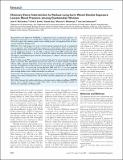| dc.contributor.author | McCracken, John Patrick | |
| dc.contributor.author | Smith, Kirk R. | |
| dc.contributor.author | Díaz, Anaité | |
| dc.contributor.author | Mittleman, Murray A. | |
| dc.contributor.author | Schwartz, Joel David | |
| dc.date.accessioned | 2011-09-13T01:44:36Z | |
| dc.date.issued | 2007 | |
| dc.identifier.citation | McCracken, John P., Kirk R. Smith, Anaité Díaz, Murray A. Mittleman, and Joel Schwartz. 2007. Chimney Stove Intervention to Reduce Long-term Wood Smoke Exposure Lowers Blood Pressure among Guatemalan Women. Environmental Health Perspectives 115(7): 996-1001. | en_US |
| dc.identifier.issn | 0091-6765 | en_US |
| dc.identifier.uri | http://nrs.harvard.edu/urn-3:HUL.InstRepos:5129835 | |
| dc.description.abstract | Background and Objective: RESPIRE, a randomized trial of an improved cookstove, was conducted in Guatemala to assess health effects of long-term reductions in wood smoke exposure. Given the evidence that ambient particles increase blood pressure, we hypothesized that the intervention would lower blood pressure. Methods: Two study designs were used: a) between-group comparisons based on randomized stove assignment, and b) before-and-after comparisons within subjects before and after they received improved stoves. From 2003 to 2005, we measured personal fine particle (particulate matter with aerodynamic diameter < 2.5 μm; PM2.5) exposures and systolic (SBP) and diastolic blood pressure (DBP) among women > 38 years of age from the chimney woodstove intervention group (49 subjects) and traditional open wood fire control group (71 subjects). Measures were repeated up to three occasions. Results: Daily average PM2.5 exposures were 264 and 102 μg/m3 in the control and intervention groups, respectively. After adjusting for age, body mass index, an asset index, smoking, secondhand tobacco smoke, apparent temperature, season, day of week, time of day, and a random subject intercept, the improved stove intervention was associated with 3.7 mm Hg lower SBP [95% confidence interval (CI), −8.1 to 0.6] and 3.0 mm Hg lower DBP (95% CI, −5.7 to −0.4) compared with controls. In the second study design, among 55 control subjects measured both before and after receiving chimney stoves, similar associations were observed. Conclusion: The between-group comparisons provide evidence, particularly for DBP, that the chimney stove reduces blood pressure, and the before-and-after comparisons are consistent with this evidence. | en_US |
| dc.language.iso | en_US | en_US |
| dc.publisher | National Institute of Environmental Health Sciences | en_US |
| dc.relation.isversionof | doi:10.1289/ehp.9888 | en_US |
| dc.relation.hasversion | http://www.ncbi.nlm.nih.gov/pmc/articles/PMC1913602/pdf/ | en_US |
| dash.license | LAA | |
| dc.subject | biomass fuel | en_US |
| dc.subject | cardiovascular disease | en_US |
| dc.subject | echo-intervention | en_US |
| dc.subject | indoor air pollution | en_US |
| dc.subject | RESPIRE project | en_US |
| dc.title | Chimney Stove Intervention to Reduce Long-term Wood Smoke Exposure Lowers Blood Pressure among Guatemalan Women | en_US |
| dc.type | Journal Article | en_US |
| dc.description.version | Version of Record | en_US |
| dc.relation.journal | Environmental Health Perspectives | en_US |
| dash.depositing.author | McCracken, John Patrick | |
| dc.date.available | 2011-09-13T01:44:36Z | |
| dash.affiliation.other | SPH^Exposure Epidemiology and Risk Program | en_US |
| dash.affiliation.other | HMS^Medicine-Brigham and Women's Hospital | en_US |
| dash.affiliation.other | SPH^Exposure Epidemiology and Risk Program | en_US |
| dc.identifier.doi | 10.1289/ehp.9888 | * |
| dash.contributor.affiliated | McCracken, John Patrick | |
| dash.contributor.affiliated | Mittleman, Murray | |
| dash.contributor.affiliated | Schwartz, Joel | |
| dc.identifier.orcid | 0000-0002-2557-150X | |


